Leadership Style Evaluation and Analysis: A Detailed Report
VerifiedAdded on 2020/04/01
|10
|2132
|173
Report
AI Summary
This report presents a critical analysis of a student's leadership style, focusing on a participative approach. The report begins with an introduction to leadership roles within an organization, emphasizing the importance of managerial leadership and the need to consider employees as individuals. The student then provides a self-assessment of their leadership style, identifying strengths such as communication and relationship-building skills, and weaknesses like public speaking and time management. The report further explores the application of the Servicescape Model in a service-based organization and delves into various leadership theories, including participative, behavioral, and contingency theories, and their relevance. The conclusion reiterates the student's participative leadership style and their commitment to contributing to the betterment of society. This assignment is a valuable resource for students seeking insights into leadership principles and self-assessment.
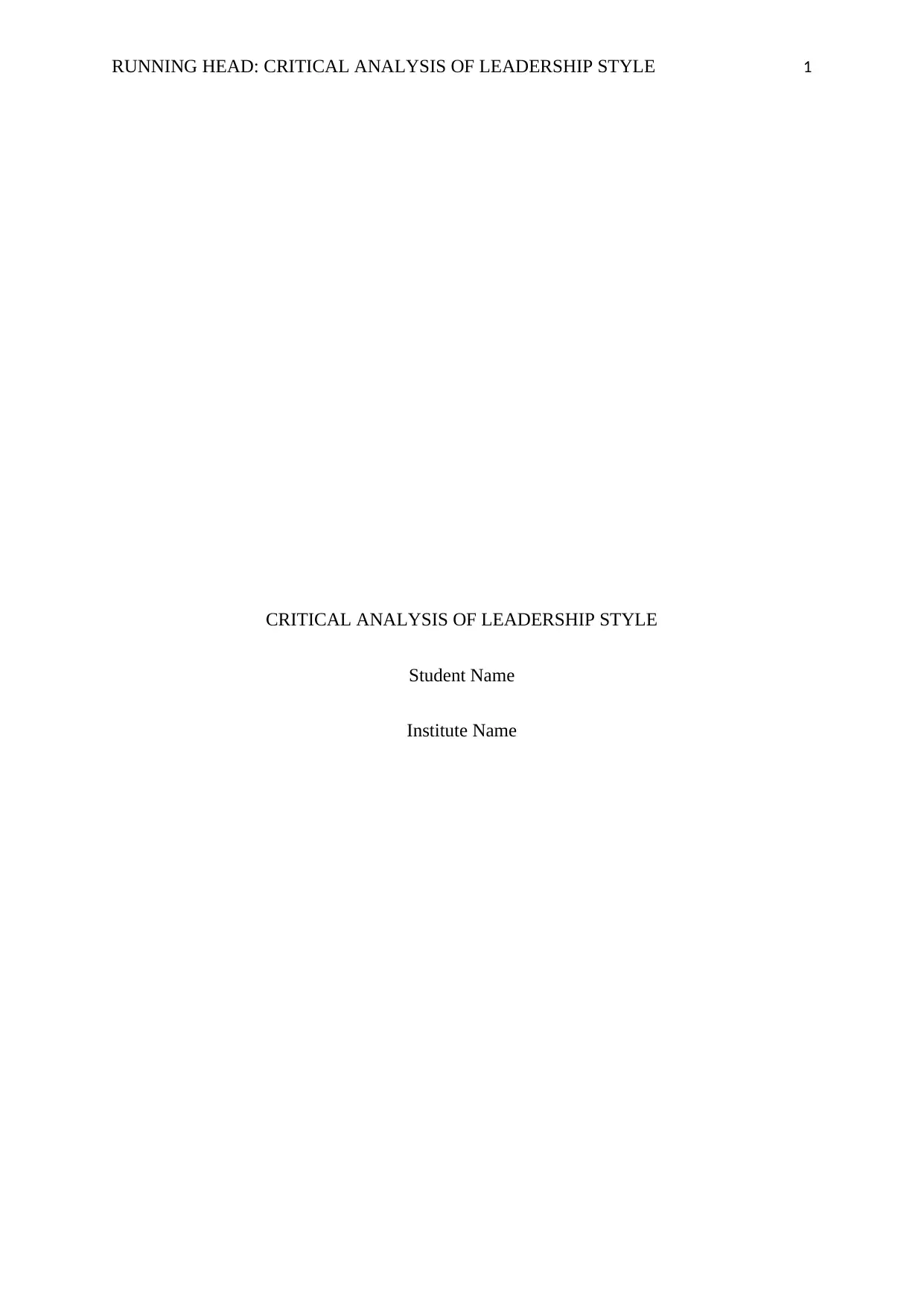
RUNNING HEAD: CRITICAL ANALYSIS OF LEADERSHIP STYLE 1
CRITICAL ANALYSIS OF LEADERSHIP STYLE
Student Name
Institute Name
CRITICAL ANALYSIS OF LEADERSHIP STYLE
Student Name
Institute Name
Paraphrase This Document
Need a fresh take? Get an instant paraphrase of this document with our AI Paraphraser
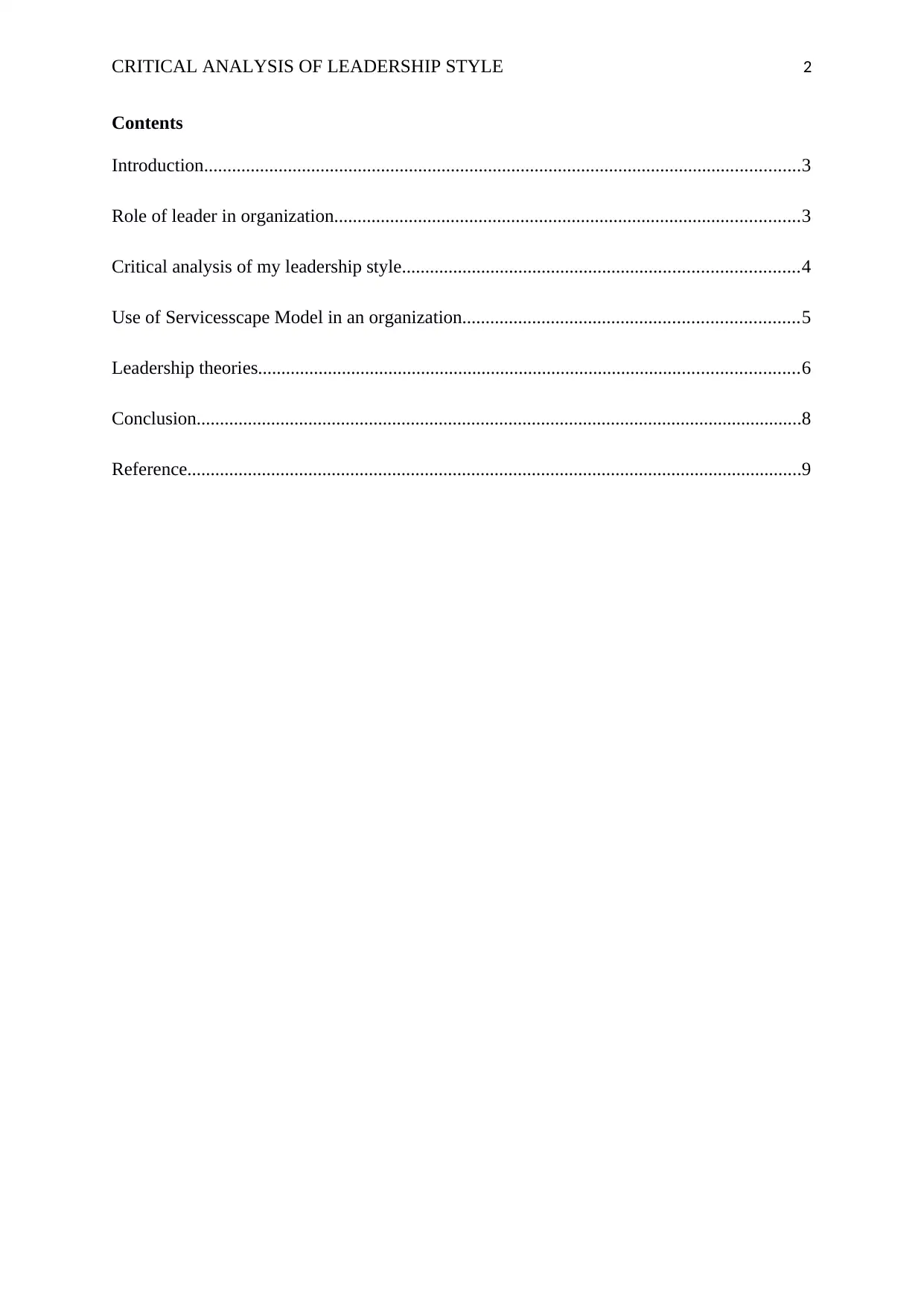
CRITICAL ANALYSIS OF LEADERSHIP STYLE 2
Contents
Introduction................................................................................................................................3
Role of leader in organization....................................................................................................3
Critical analysis of my leadership style.....................................................................................4
Use of Servicesscape Model in an organization........................................................................5
Leadership theories....................................................................................................................6
Conclusion..................................................................................................................................8
Reference....................................................................................................................................9
Contents
Introduction................................................................................................................................3
Role of leader in organization....................................................................................................3
Critical analysis of my leadership style.....................................................................................4
Use of Servicesscape Model in an organization........................................................................5
Leadership theories....................................................................................................................6
Conclusion..................................................................................................................................8
Reference....................................................................................................................................9
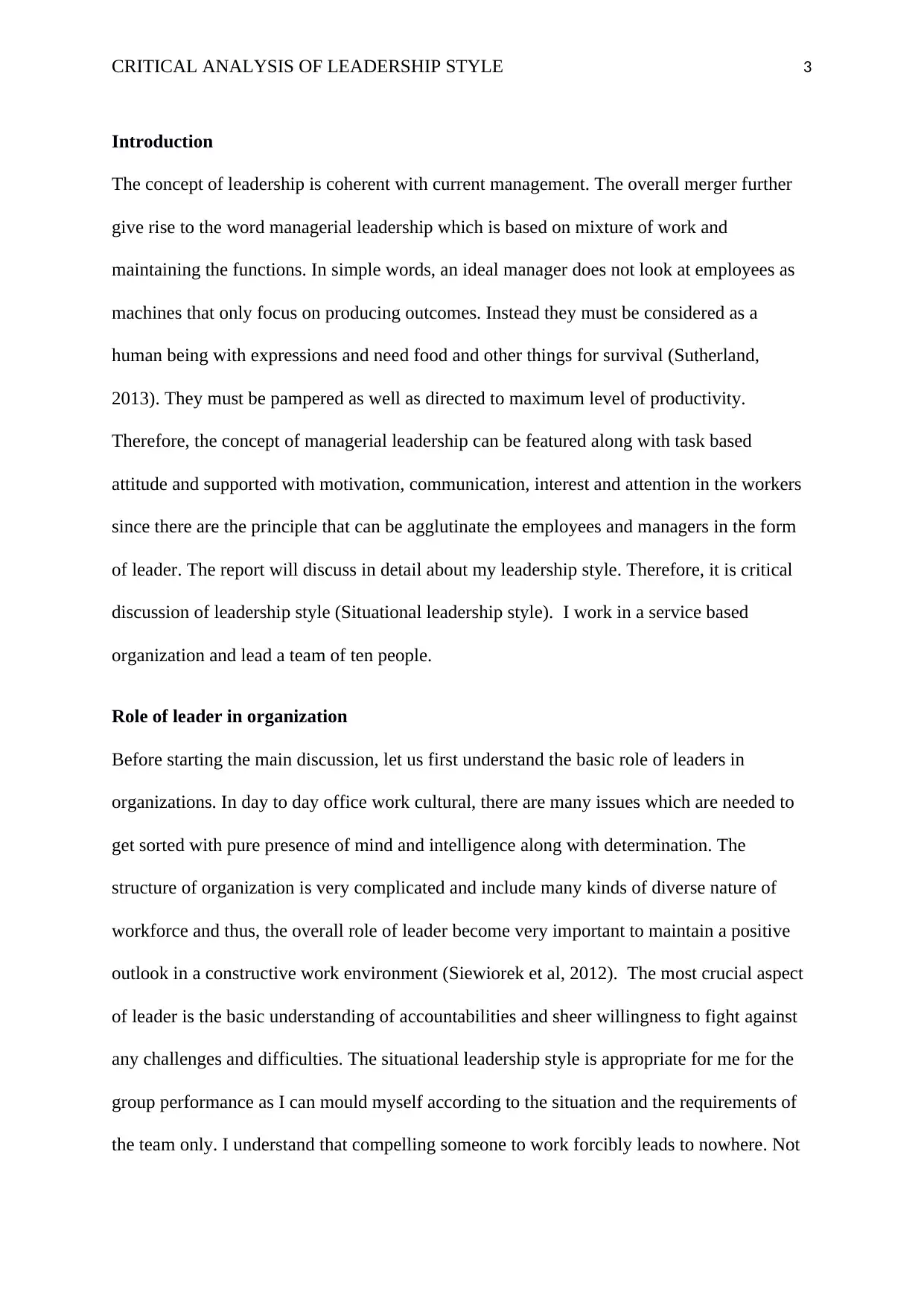
CRITICAL ANALYSIS OF LEADERSHIP STYLE 3
Introduction
The concept of leadership is coherent with current management. The overall merger further
give rise to the word managerial leadership which is based on mixture of work and
maintaining the functions. In simple words, an ideal manager does not look at employees as
machines that only focus on producing outcomes. Instead they must be considered as a
human being with expressions and need food and other things for survival (Sutherland,
2013). They must be pampered as well as directed to maximum level of productivity.
Therefore, the concept of managerial leadership can be featured along with task based
attitude and supported with motivation, communication, interest and attention in the workers
since there are the principle that can be agglutinate the employees and managers in the form
of leader. The report will discuss in detail about my leadership style. Therefore, it is critical
discussion of leadership style (Situational leadership style). I work in a service based
organization and lead a team of ten people.
Role of leader in organization
Before starting the main discussion, let us first understand the basic role of leaders in
organizations. In day to day office work cultural, there are many issues which are needed to
get sorted with pure presence of mind and intelligence along with determination. The
structure of organization is very complicated and include many kinds of diverse nature of
workforce and thus, the overall role of leader become very important to maintain a positive
outlook in a constructive work environment (Siewiorek et al, 2012). The most crucial aspect
of leader is the basic understanding of accountabilities and sheer willingness to fight against
any challenges and difficulties. The situational leadership style is appropriate for me for the
group performance as I can mould myself according to the situation and the requirements of
the team only. I understand that compelling someone to work forcibly leads to nowhere. Not
Introduction
The concept of leadership is coherent with current management. The overall merger further
give rise to the word managerial leadership which is based on mixture of work and
maintaining the functions. In simple words, an ideal manager does not look at employees as
machines that only focus on producing outcomes. Instead they must be considered as a
human being with expressions and need food and other things for survival (Sutherland,
2013). They must be pampered as well as directed to maximum level of productivity.
Therefore, the concept of managerial leadership can be featured along with task based
attitude and supported with motivation, communication, interest and attention in the workers
since there are the principle that can be agglutinate the employees and managers in the form
of leader. The report will discuss in detail about my leadership style. Therefore, it is critical
discussion of leadership style (Situational leadership style). I work in a service based
organization and lead a team of ten people.
Role of leader in organization
Before starting the main discussion, let us first understand the basic role of leaders in
organizations. In day to day office work cultural, there are many issues which are needed to
get sorted with pure presence of mind and intelligence along with determination. The
structure of organization is very complicated and include many kinds of diverse nature of
workforce and thus, the overall role of leader become very important to maintain a positive
outlook in a constructive work environment (Siewiorek et al, 2012). The most crucial aspect
of leader is the basic understanding of accountabilities and sheer willingness to fight against
any challenges and difficulties. The situational leadership style is appropriate for me for the
group performance as I can mould myself according to the situation and the requirements of
the team only. I understand that compelling someone to work forcibly leads to nowhere. Not
⊘ This is a preview!⊘
Do you want full access?
Subscribe today to unlock all pages.

Trusted by 1+ million students worldwide
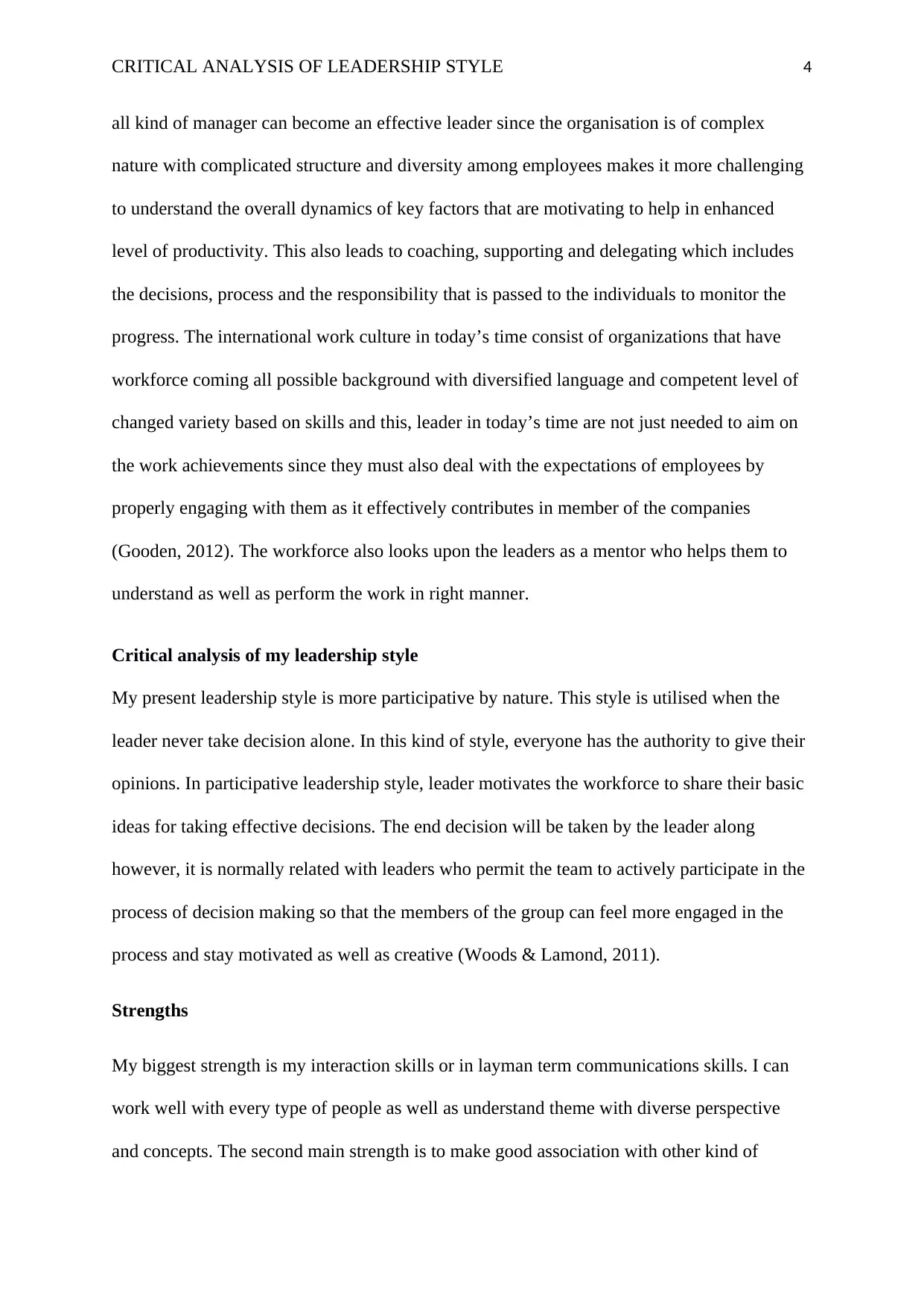
CRITICAL ANALYSIS OF LEADERSHIP STYLE 4
all kind of manager can become an effective leader since the organisation is of complex
nature with complicated structure and diversity among employees makes it more challenging
to understand the overall dynamics of key factors that are motivating to help in enhanced
level of productivity. This also leads to coaching, supporting and delegating which includes
the decisions, process and the responsibility that is passed to the individuals to monitor the
progress. The international work culture in today’s time consist of organizations that have
workforce coming all possible background with diversified language and competent level of
changed variety based on skills and this, leader in today’s time are not just needed to aim on
the work achievements since they must also deal with the expectations of employees by
properly engaging with them as it effectively contributes in member of the companies
(Gooden, 2012). The workforce also looks upon the leaders as a mentor who helps them to
understand as well as perform the work in right manner.
Critical analysis of my leadership style
My present leadership style is more participative by nature. This style is utilised when the
leader never take decision alone. In this kind of style, everyone has the authority to give their
opinions. In participative leadership style, leader motivates the workforce to share their basic
ideas for taking effective decisions. The end decision will be taken by the leader along
however, it is normally related with leaders who permit the team to actively participate in the
process of decision making so that the members of the group can feel more engaged in the
process and stay motivated as well as creative (Woods & Lamond, 2011).
Strengths
My biggest strength is my interaction skills or in layman term communications skills. I can
work well with every type of people as well as understand theme with diverse perspective
and concepts. The second main strength is to make good association with other kind of
all kind of manager can become an effective leader since the organisation is of complex
nature with complicated structure and diversity among employees makes it more challenging
to understand the overall dynamics of key factors that are motivating to help in enhanced
level of productivity. This also leads to coaching, supporting and delegating which includes
the decisions, process and the responsibility that is passed to the individuals to monitor the
progress. The international work culture in today’s time consist of organizations that have
workforce coming all possible background with diversified language and competent level of
changed variety based on skills and this, leader in today’s time are not just needed to aim on
the work achievements since they must also deal with the expectations of employees by
properly engaging with them as it effectively contributes in member of the companies
(Gooden, 2012). The workforce also looks upon the leaders as a mentor who helps them to
understand as well as perform the work in right manner.
Critical analysis of my leadership style
My present leadership style is more participative by nature. This style is utilised when the
leader never take decision alone. In this kind of style, everyone has the authority to give their
opinions. In participative leadership style, leader motivates the workforce to share their basic
ideas for taking effective decisions. The end decision will be taken by the leader along
however, it is normally related with leaders who permit the team to actively participate in the
process of decision making so that the members of the group can feel more engaged in the
process and stay motivated as well as creative (Woods & Lamond, 2011).
Strengths
My biggest strength is my interaction skills or in layman term communications skills. I can
work well with every type of people as well as understand theme with diverse perspective
and concepts. The second main strength is to make good association with other kind of
Paraphrase This Document
Need a fresh take? Get an instant paraphrase of this document with our AI Paraphraser
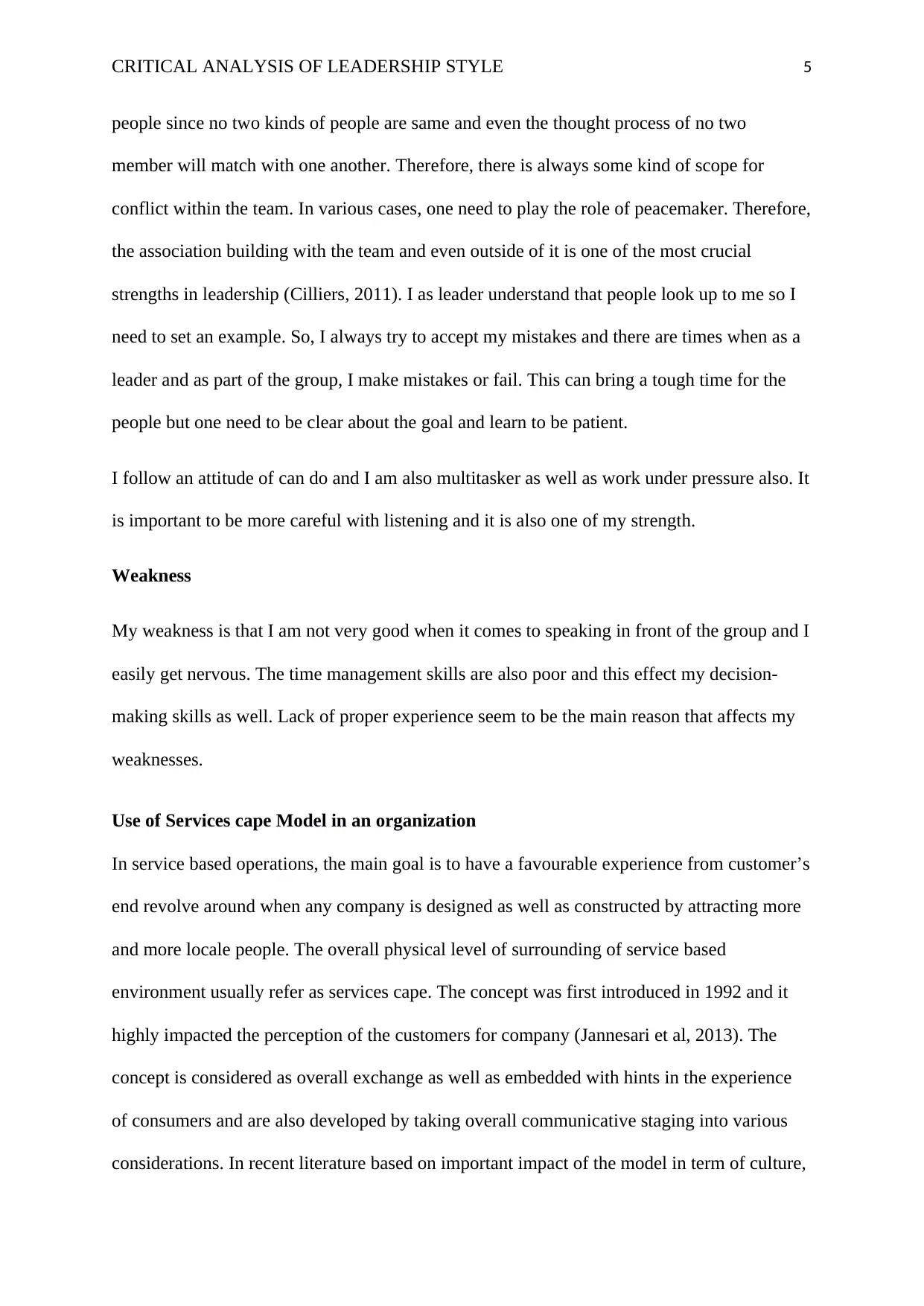
CRITICAL ANALYSIS OF LEADERSHIP STYLE 5
people since no two kinds of people are same and even the thought process of no two
member will match with one another. Therefore, there is always some kind of scope for
conflict within the team. In various cases, one need to play the role of peacemaker. Therefore,
the association building with the team and even outside of it is one of the most crucial
strengths in leadership (Cilliers, 2011). I as leader understand that people look up to me so I
need to set an example. So, I always try to accept my mistakes and there are times when as a
leader and as part of the group, I make mistakes or fail. This can bring a tough time for the
people but one need to be clear about the goal and learn to be patient.
I follow an attitude of can do and I am also multitasker as well as work under pressure also. It
is important to be more careful with listening and it is also one of my strength.
Weakness
My weakness is that I am not very good when it comes to speaking in front of the group and I
easily get nervous. The time management skills are also poor and this effect my decision-
making skills as well. Lack of proper experience seem to be the main reason that affects my
weaknesses.
Use of Services cape Model in an organization
In service based operations, the main goal is to have a favourable experience from customer’s
end revolve around when any company is designed as well as constructed by attracting more
and more locale people. The overall physical level of surrounding of service based
environment usually refer as services cape. The concept was first introduced in 1992 and it
highly impacted the perception of the customers for company (Jannesari et al, 2013). The
concept is considered as overall exchange as well as embedded with hints in the experience
of consumers and are also developed by taking overall communicative staging into various
considerations. In recent literature based on important impact of the model in term of culture,
people since no two kinds of people are same and even the thought process of no two
member will match with one another. Therefore, there is always some kind of scope for
conflict within the team. In various cases, one need to play the role of peacemaker. Therefore,
the association building with the team and even outside of it is one of the most crucial
strengths in leadership (Cilliers, 2011). I as leader understand that people look up to me so I
need to set an example. So, I always try to accept my mistakes and there are times when as a
leader and as part of the group, I make mistakes or fail. This can bring a tough time for the
people but one need to be clear about the goal and learn to be patient.
I follow an attitude of can do and I am also multitasker as well as work under pressure also. It
is important to be more careful with listening and it is also one of my strength.
Weakness
My weakness is that I am not very good when it comes to speaking in front of the group and I
easily get nervous. The time management skills are also poor and this effect my decision-
making skills as well. Lack of proper experience seem to be the main reason that affects my
weaknesses.
Use of Services cape Model in an organization
In service based operations, the main goal is to have a favourable experience from customer’s
end revolve around when any company is designed as well as constructed by attracting more
and more locale people. The overall physical level of surrounding of service based
environment usually refer as services cape. The concept was first introduced in 1992 and it
highly impacted the perception of the customers for company (Jannesari et al, 2013). The
concept is considered as overall exchange as well as embedded with hints in the experience
of consumers and are also developed by taking overall communicative staging into various
considerations. In recent literature based on important impact of the model in term of culture,
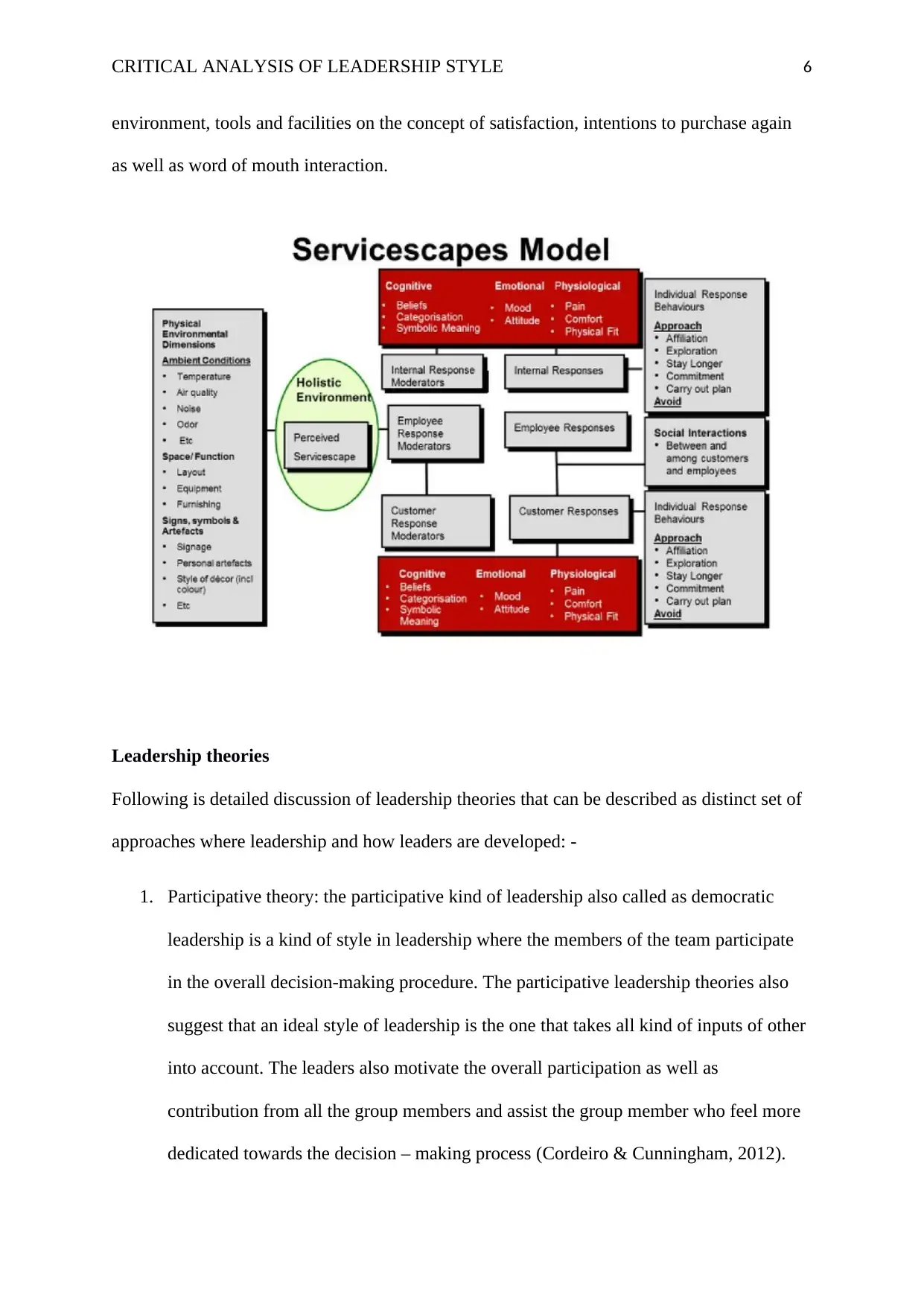
CRITICAL ANALYSIS OF LEADERSHIP STYLE 6
environment, tools and facilities on the concept of satisfaction, intentions to purchase again
as well as word of mouth interaction.
Leadership theories
Following is detailed discussion of leadership theories that can be described as distinct set of
approaches where leadership and how leaders are developed: -
1. Participative theory: the participative kind of leadership also called as democratic
leadership is a kind of style in leadership where the members of the team participate
in the overall decision-making procedure. The participative leadership theories also
suggest that an ideal style of leadership is the one that takes all kind of inputs of other
into account. The leaders also motivate the overall participation as well as
contribution from all the group members and assist the group member who feel more
dedicated towards the decision – making process (Cordeiro & Cunningham, 2012).
environment, tools and facilities on the concept of satisfaction, intentions to purchase again
as well as word of mouth interaction.
Leadership theories
Following is detailed discussion of leadership theories that can be described as distinct set of
approaches where leadership and how leaders are developed: -
1. Participative theory: the participative kind of leadership also called as democratic
leadership is a kind of style in leadership where the members of the team participate
in the overall decision-making procedure. The participative leadership theories also
suggest that an ideal style of leadership is the one that takes all kind of inputs of other
into account. The leaders also motivate the overall participation as well as
contribution from all the group members and assist the group member who feel more
dedicated towards the decision – making process (Cordeiro & Cunningham, 2012).
⊘ This is a preview!⊘
Do you want full access?
Subscribe today to unlock all pages.

Trusted by 1+ million students worldwide
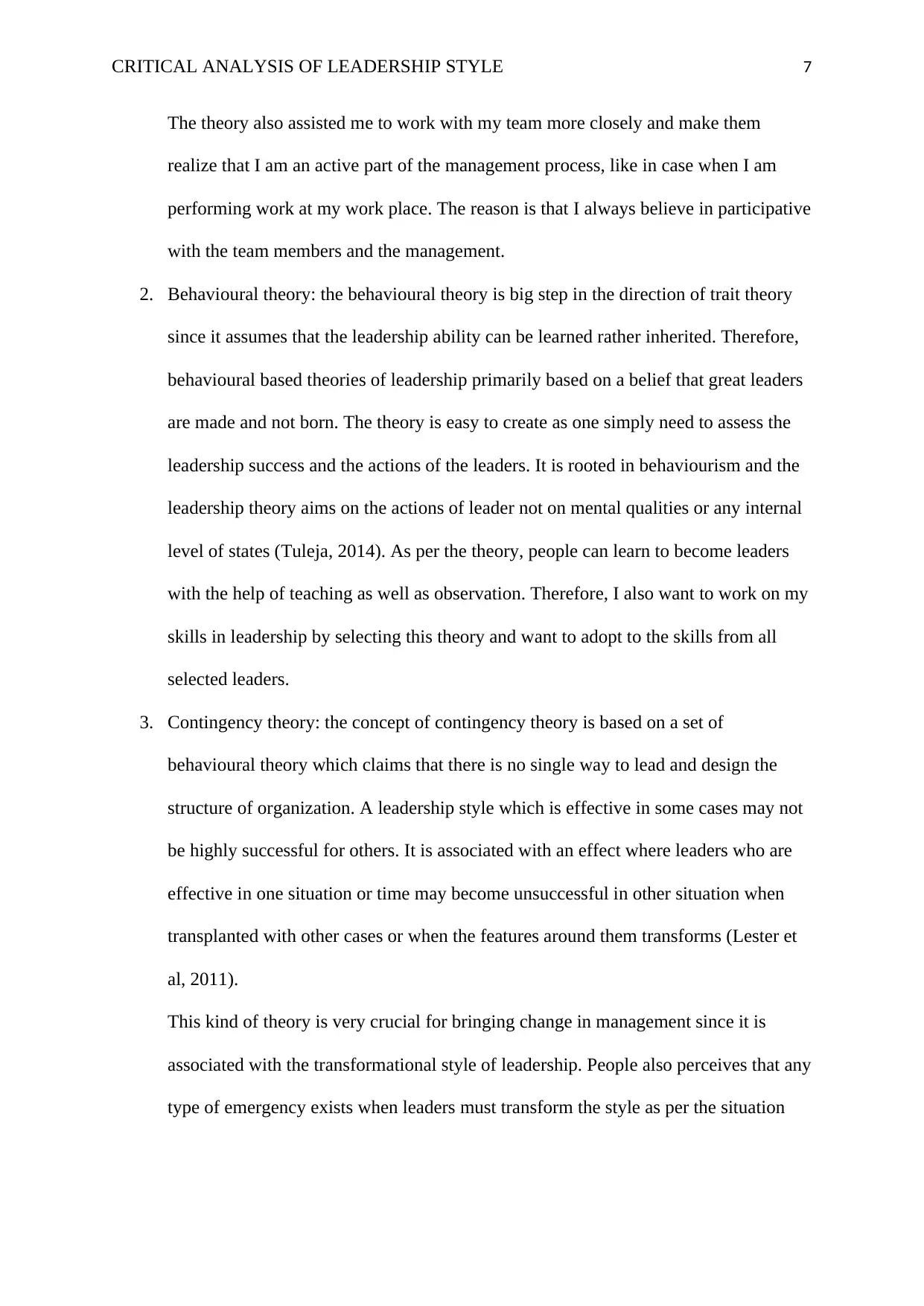
CRITICAL ANALYSIS OF LEADERSHIP STYLE 7
The theory also assisted me to work with my team more closely and make them
realize that I am an active part of the management process, like in case when I am
performing work at my work place. The reason is that I always believe in participative
with the team members and the management.
2. Behavioural theory: the behavioural theory is big step in the direction of trait theory
since it assumes that the leadership ability can be learned rather inherited. Therefore,
behavioural based theories of leadership primarily based on a belief that great leaders
are made and not born. The theory is easy to create as one simply need to assess the
leadership success and the actions of the leaders. It is rooted in behaviourism and the
leadership theory aims on the actions of leader not on mental qualities or any internal
level of states (Tuleja, 2014). As per the theory, people can learn to become leaders
with the help of teaching as well as observation. Therefore, I also want to work on my
skills in leadership by selecting this theory and want to adopt to the skills from all
selected leaders.
3. Contingency theory: the concept of contingency theory is based on a set of
behavioural theory which claims that there is no single way to lead and design the
structure of organization. A leadership style which is effective in some cases may not
be highly successful for others. It is associated with an effect where leaders who are
effective in one situation or time may become unsuccessful in other situation when
transplanted with other cases or when the features around them transforms (Lester et
al, 2011).
This kind of theory is very crucial for bringing change in management since it is
associated with the transformational style of leadership. People also perceives that any
type of emergency exists when leaders must transform the style as per the situation
The theory also assisted me to work with my team more closely and make them
realize that I am an active part of the management process, like in case when I am
performing work at my work place. The reason is that I always believe in participative
with the team members and the management.
2. Behavioural theory: the behavioural theory is big step in the direction of trait theory
since it assumes that the leadership ability can be learned rather inherited. Therefore,
behavioural based theories of leadership primarily based on a belief that great leaders
are made and not born. The theory is easy to create as one simply need to assess the
leadership success and the actions of the leaders. It is rooted in behaviourism and the
leadership theory aims on the actions of leader not on mental qualities or any internal
level of states (Tuleja, 2014). As per the theory, people can learn to become leaders
with the help of teaching as well as observation. Therefore, I also want to work on my
skills in leadership by selecting this theory and want to adopt to the skills from all
selected leaders.
3. Contingency theory: the concept of contingency theory is based on a set of
behavioural theory which claims that there is no single way to lead and design the
structure of organization. A leadership style which is effective in some cases may not
be highly successful for others. It is associated with an effect where leaders who are
effective in one situation or time may become unsuccessful in other situation when
transplanted with other cases or when the features around them transforms (Lester et
al, 2011).
This kind of theory is very crucial for bringing change in management since it is
associated with the transformational style of leadership. People also perceives that any
type of emergency exists when leaders must transform the style as per the situation
Paraphrase This Document
Need a fresh take? Get an instant paraphrase of this document with our AI Paraphraser
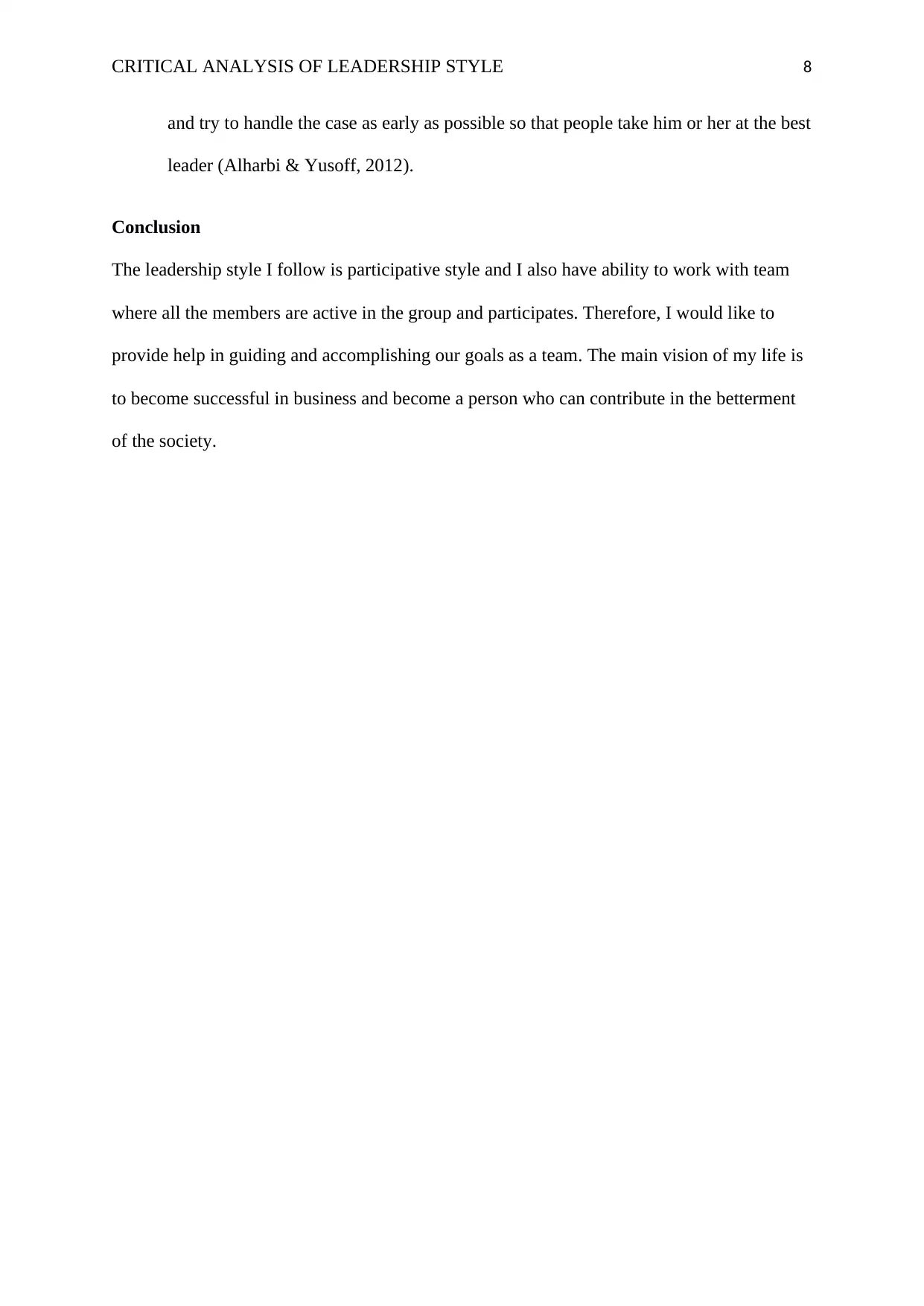
CRITICAL ANALYSIS OF LEADERSHIP STYLE 8
and try to handle the case as early as possible so that people take him or her at the best
leader (Alharbi & Yusoff, 2012).
Conclusion
The leadership style I follow is participative style and I also have ability to work with team
where all the members are active in the group and participates. Therefore, I would like to
provide help in guiding and accomplishing our goals as a team. The main vision of my life is
to become successful in business and become a person who can contribute in the betterment
of the society.
and try to handle the case as early as possible so that people take him or her at the best
leader (Alharbi & Yusoff, 2012).
Conclusion
The leadership style I follow is participative style and I also have ability to work with team
where all the members are active in the group and participates. Therefore, I would like to
provide help in guiding and accomplishing our goals as a team. The main vision of my life is
to become successful in business and become a person who can contribute in the betterment
of the society.
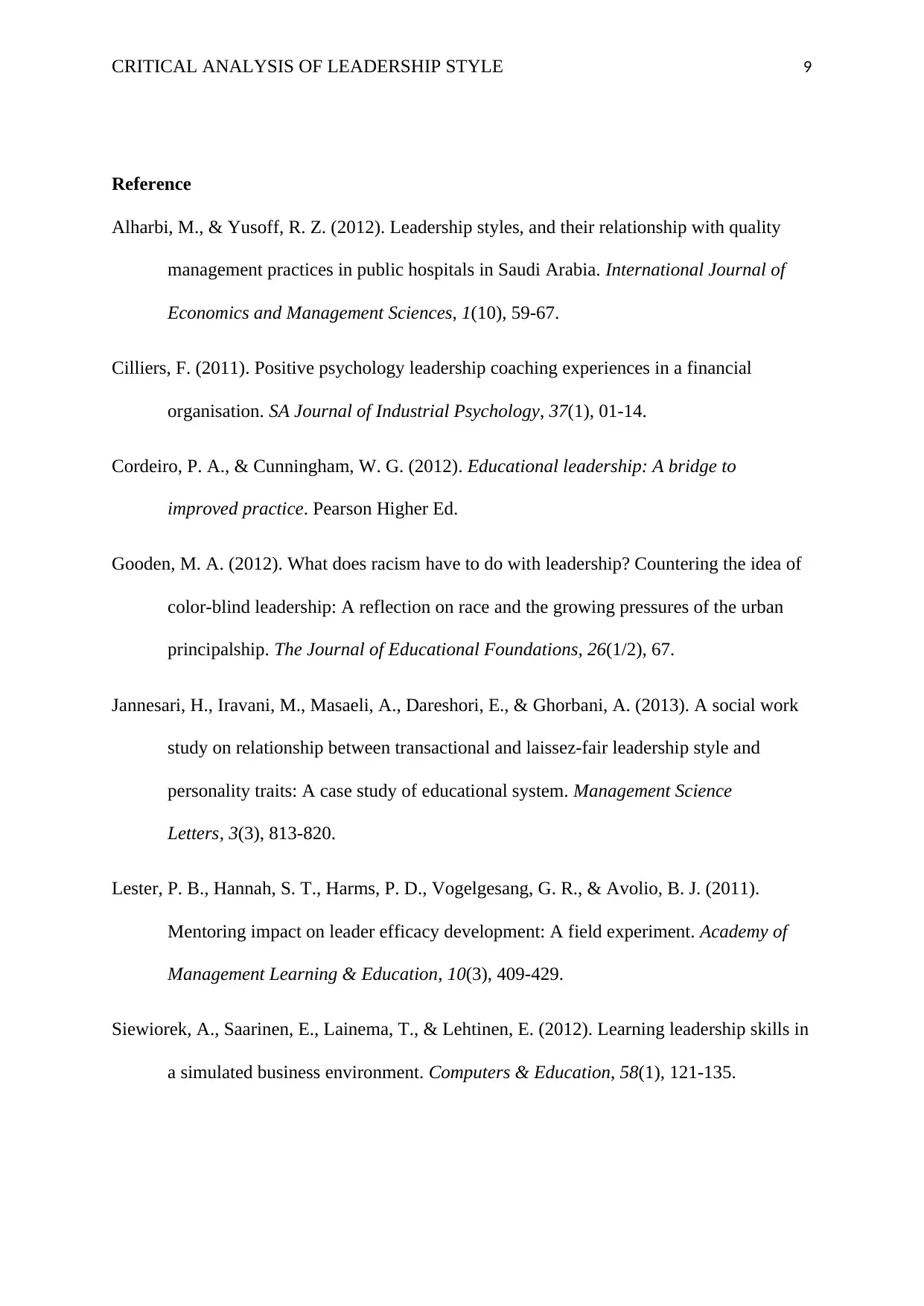
CRITICAL ANALYSIS OF LEADERSHIP STYLE 9
Reference
Alharbi, M., & Yusoff, R. Z. (2012). Leadership styles, and their relationship with quality
management practices in public hospitals in Saudi Arabia. International Journal of
Economics and Management Sciences, 1(10), 59-67.
Cilliers, F. (2011). Positive psychology leadership coaching experiences in a financial
organisation. SA Journal of Industrial Psychology, 37(1), 01-14.
Cordeiro, P. A., & Cunningham, W. G. (2012). Educational leadership: A bridge to
improved practice. Pearson Higher Ed.
Gooden, M. A. (2012). What does racism have to do with leadership? Countering the idea of
color-blind leadership: A reflection on race and the growing pressures of the urban
principalship. The Journal of Educational Foundations, 26(1/2), 67.
Jannesari, H., Iravani, M., Masaeli, A., Dareshori, E., & Ghorbani, A. (2013). A social work
study on relationship between transactional and laissez-fair leadership style and
personality traits: A case study of educational system. Management Science
Letters, 3(3), 813-820.
Lester, P. B., Hannah, S. T., Harms, P. D., Vogelgesang, G. R., & Avolio, B. J. (2011).
Mentoring impact on leader efficacy development: A field experiment. Academy of
Management Learning & Education, 10(3), 409-429.
Siewiorek, A., Saarinen, E., Lainema, T., & Lehtinen, E. (2012). Learning leadership skills in
a simulated business environment. Computers & Education, 58(1), 121-135.
Reference
Alharbi, M., & Yusoff, R. Z. (2012). Leadership styles, and their relationship with quality
management practices in public hospitals in Saudi Arabia. International Journal of
Economics and Management Sciences, 1(10), 59-67.
Cilliers, F. (2011). Positive psychology leadership coaching experiences in a financial
organisation. SA Journal of Industrial Psychology, 37(1), 01-14.
Cordeiro, P. A., & Cunningham, W. G. (2012). Educational leadership: A bridge to
improved practice. Pearson Higher Ed.
Gooden, M. A. (2012). What does racism have to do with leadership? Countering the idea of
color-blind leadership: A reflection on race and the growing pressures of the urban
principalship. The Journal of Educational Foundations, 26(1/2), 67.
Jannesari, H., Iravani, M., Masaeli, A., Dareshori, E., & Ghorbani, A. (2013). A social work
study on relationship between transactional and laissez-fair leadership style and
personality traits: A case study of educational system. Management Science
Letters, 3(3), 813-820.
Lester, P. B., Hannah, S. T., Harms, P. D., Vogelgesang, G. R., & Avolio, B. J. (2011).
Mentoring impact on leader efficacy development: A field experiment. Academy of
Management Learning & Education, 10(3), 409-429.
Siewiorek, A., Saarinen, E., Lainema, T., & Lehtinen, E. (2012). Learning leadership skills in
a simulated business environment. Computers & Education, 58(1), 121-135.
⊘ This is a preview!⊘
Do you want full access?
Subscribe today to unlock all pages.

Trusted by 1+ million students worldwide
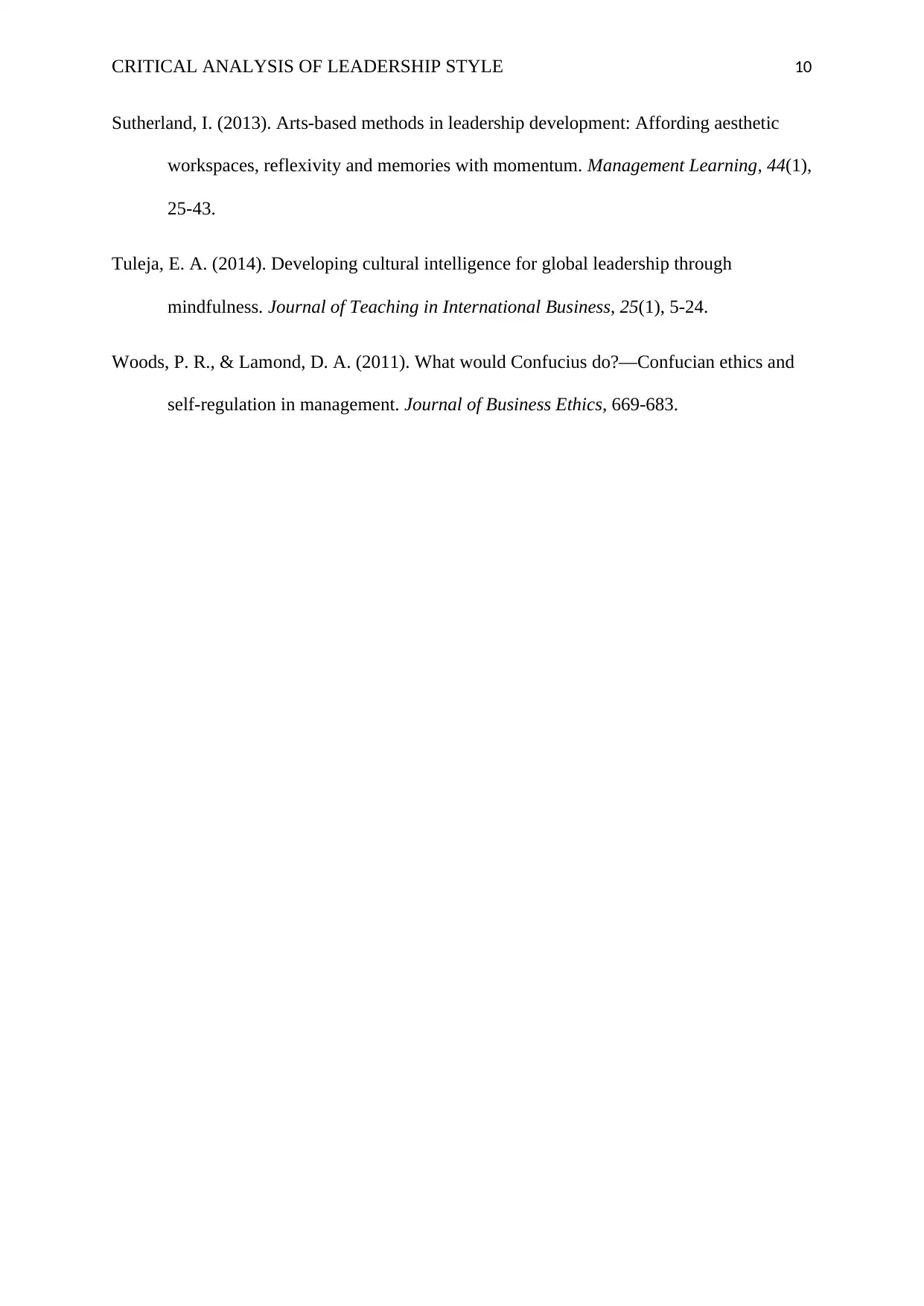
CRITICAL ANALYSIS OF LEADERSHIP STYLE 10
Sutherland, I. (2013). Arts-based methods in leadership development: Affording aesthetic
workspaces, reflexivity and memories with momentum. Management Learning, 44(1),
25-43.
Tuleja, E. A. (2014). Developing cultural intelligence for global leadership through
mindfulness. Journal of Teaching in International Business, 25(1), 5-24.
Woods, P. R., & Lamond, D. A. (2011). What would Confucius do?—Confucian ethics and
self-regulation in management. Journal of Business Ethics, 669-683.
Sutherland, I. (2013). Arts-based methods in leadership development: Affording aesthetic
workspaces, reflexivity and memories with momentum. Management Learning, 44(1),
25-43.
Tuleja, E. A. (2014). Developing cultural intelligence for global leadership through
mindfulness. Journal of Teaching in International Business, 25(1), 5-24.
Woods, P. R., & Lamond, D. A. (2011). What would Confucius do?—Confucian ethics and
self-regulation in management. Journal of Business Ethics, 669-683.
1 out of 10
Related Documents
Your All-in-One AI-Powered Toolkit for Academic Success.
+13062052269
info@desklib.com
Available 24*7 on WhatsApp / Email
![[object Object]](/_next/static/media/star-bottom.7253800d.svg)
Unlock your academic potential
Copyright © 2020–2025 A2Z Services. All Rights Reserved. Developed and managed by ZUCOL.



